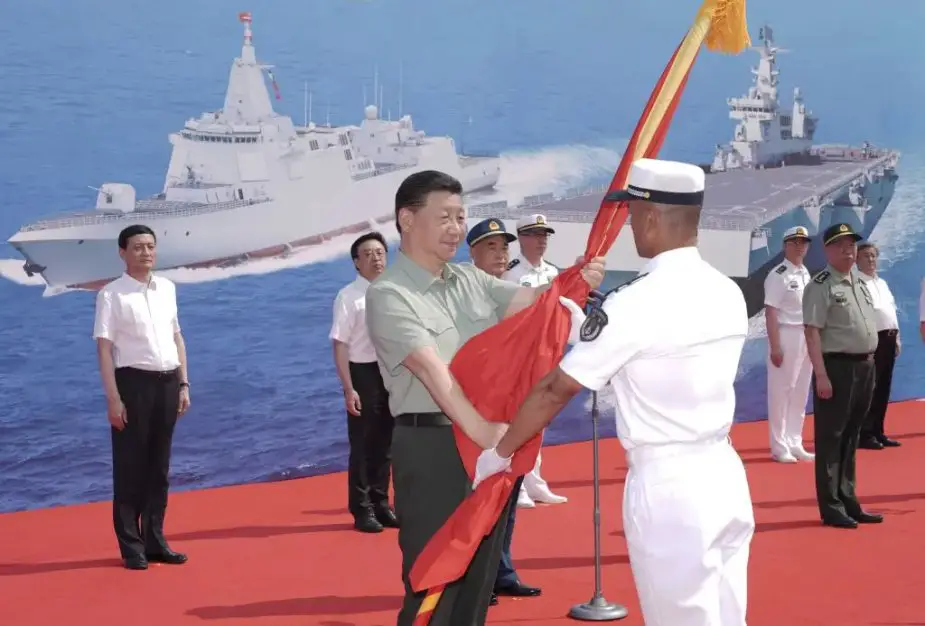According to information published by Congressional Research Service on March 9, 2021, China’s navy, which China has been steadily modernizing has become a formidable military force within China’s near-seas region, and it is conducting a growing number of operations in more-distant waters, including the broader waters of the Western Pacific, the Indian Ocean.
Follow Navy Recognition on Google News at this link
 President Xi Jinping during the ceremony of commission for the Jin-class (Type 094A) ballistic-missile submarine Changzheng-18, Renhai-class (Type 055) destroyer Dalian, and Yushen-class (Type 075) amphibious assault ship Hainan, April 23, 2021. (Picture source: Business Insider)
President Xi Jinping during the ceremony of commission for the Jin-class (Type 094A) ballistic-missile submarine Changzheng-18, Renhai-class (Type 055) destroyer Dalian, and Yushen-class (Type 075) amphibious assault ship Hainan, April 23, 2021. (Picture source: Business Insider)
A modernization since 25 years
China’s naval modernization effort, which forms part of a broader Chinese military modernization effort that includes several additional areas of emphasis, has been underway for more than 25 years, since the early to mid-1990s, and has transformed China’s navy into a much more modern and capable force. China’s navy is conducting a growing number of operations in more-distant waters, including the broader waters of the Western Pacific, the Indian Ocean.
The largest Navy in the world
China’s navy is, by far, the largest of any country in East Asia, and within the past few years it has surpassed the U.S. Navy in numbers of battle force ships (meaning the types of ships that count toward the quoted size of the U.S. Navy), making China’s navy the numerically largest in the world. Some U.S. observers are expressing concern or alarm regarding the pace of China’s naval shipbuilding effort, particularly for building larger surface ships, and resulting trend lines regarding the relative sizes China’s navy and the U.S. Navy. At the end of 2020, China’s will have 360 battle force ships, compared with a projected total of 297 for the U.S. Navy at the end of FY2020. China will have 400 battle force ships by 2025, and 425 by 2030.
A wide naval modernization effort
A wide array of platform and weapon acquisition programs, including anti-ship ballistic missiles (ASBMs), anti-ship cruise missiles (ASCMs), submarines, surface ships, aircraft, unmanned vehicles (UVs), and supporting C4ISR (command and control, communications, computers, intelligence, surveillance, and reconnaissance) systems. China’s naval modernization effort also includes improvements in maintenance and logistics, doctrine, personnel quality, education and training, and exercises.
Domination over South China Sea and targeting Taiwan
China’s military modernization effort, including its naval modernization effort, is assessed as being aimed at developing capabilities for addressing the situation with Taiwan militarily if need be; for achieving a greater degree of control or domination over China’s near-seas region, particularly the South China Sea.
Weaknesses of the Navy
China’s navy currently is assessed as having limitations in certain areas, including joint operations with other parts of China’s military, antisubmarine warfare (ASW), long-range targeting, a limited capacity for carrying out at-sea resupply of combatant ships operating far from home waters, a need to train large numbers of personnel to crew its new ships, and a lack of recent combat experience
Increased the size of China's Coast Guard
China’s coast guard is, by far, the largest of any country in East Asia. China also operates a sizeable maritime militia that includes a large number of fishing vessels. China relies primarily on its maritime militia and coast guard to assert and defend its maritime claims in its near-seas region, with the navy operating over the horizon as a potential backup force.



